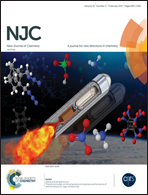Deceleration of thermal ring closure in a glass-forming mexylaminotriazine-substituted merocyanine (MC) linked to intramolecular hydrogen bonding†
Abstract
The design and synthesis of a glass-forming nitrobenzospiropyran (SP) functionalized with a mexylaminotriazine group is reported herein. The title compound was synthesized in 63% overall yield by the carbamylation of a 2-hydroxyethyl SP precursor and an amino-functionalized glass-forming triazine precursor. As a photoswitch, the colourless SP undergoes ring opening upon irradiation at 365 nm to the coloured merocyanine (MC) form. The negative solvatochromism (i.e., hypsochromic shift increasing with solvent polarity) and kinetics of thermal ring closure of the MC form were studied spectrometrically in four solvents: toluene, tetrahydrofuran, N,N-dimethylformamide and 1-propanol. Results were compared to those for previously studied related merocyanines of 6-nitroBIPs. The observed thermal reversion rate from the MC to the SP form in non-polar solvents was surprisingly slow, and is believed to be a result of intramolecular hydrogen bonding. Kinetics in solvents that can accept hydrogen bonds and analysis of activation parameters (Ea, A, ΔH‡, ΔS‡, ΔG‡) highlights the role of intramolecular hydrogen bonding for this MC derivative. Thus, the large negative ΔS‡ (−32.1 J mol−1 K−1) found for the MC reversion in toluene suggests a tighter transition state that reflects the strength of hydrogen bonding in the MC that inhibits the trans–cis isomerization that is the rate-determining step in ring closure.



 Please wait while we load your content...
Please wait while we load your content...